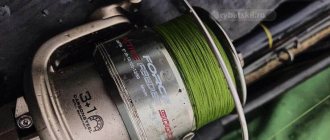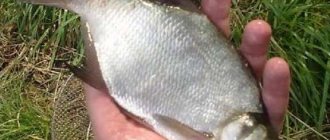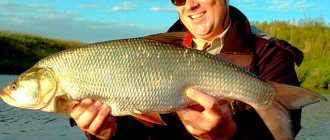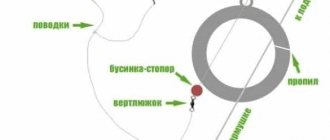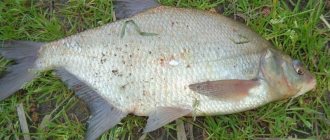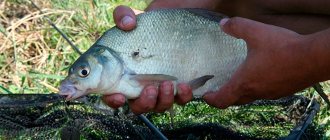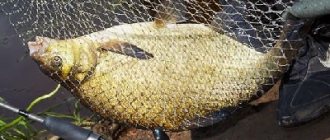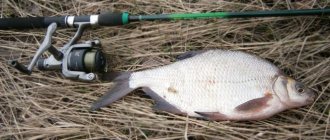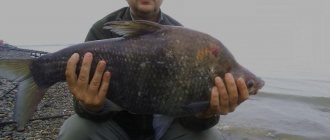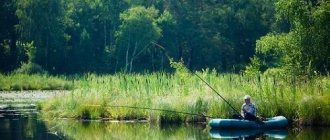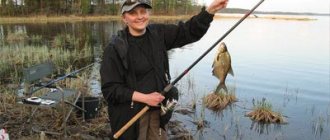The habitats of bream in summer in different reservoirs are not the same, at least according to one bottom characteristic.
Even in one reservoir, bream is unevenly distributed in summer and may give preference to different places in the river, lake, or reservoir.
Therefore, for effective bream fishing, it is important to know its habitats during long stops and bream feeding areas. And differentiate them from each other.
Bream is not a big fan of fast river flows; channel and coastal pits serve as its resting spots. In summer you can find bream living in deep-sea reaches, ridges on the river bottom and other shelters. But all these are places of concentration of inactive or well-fed bream.
That is, for most of its life, bream in rivers lives in deep places with low currents or other shelters, where too few living organisms develop and are carried by the current, and even those are quickly eaten away by bream and other fish during long stays. (Here we are talking about the habitats of bream in the hot summer)
For this reason, it often happens that even if we find a huge school of bream in the summer in its long-term habitat, we will not necessarily be satisfied with the catch of this fish.
It’s good that in the absence of a stomach, bream is forced to periodically leave its habitat during the day to feed areas to replenish vital energy. This is the period of time when fishermen catch the most active bream in the summer.
Time periods for summer bream fishing
The period of summer bream fishing, that is, in open water, can be divided into four main time periods.
In the spring, bream are better caught in warm shallows. The time period is characterized by the fact that bream (like any other fish) intensively fattens up before the upcoming spawn, feeding on high-calorie live food.
The second time period for bream fishing occurs at the beginning of the summer period. About a week after spawning, the fish begin to really eat. At the beginning of the summer feeding period, bream are better caught using live baits, although, often, they do not refuse baits of plant origin.
The third period refers to the hottest summer season of the year with the worst fishing conditions not only for bream, but also for other “white” fish. The time period is characterized by weak bream activity.
In addition, by the middle of the summer period, many fish of the carp family switch to feeding on young shoots of algae, which bream has no problems finding, so the fish quickly become saturated.
Summer bream fishing becomes less productive in the shallows, where the oxygen balance deteriorates significantly due to overheating of the water. Therefore, bream are forced to spend most of the daylight hours in cool, deep holes.
The best time period of the day for catching bream in the shallows in July - early August corresponds to evening twilight - night - early dawn. For night summer bream fishing, it is better to use moving baits. Although the fish will also smell odorous plant baits.
The fourth period of summer bream fishing begins around mid-August. At this time, the bream begins to prepare for the winter season. Closer to autumn, bream are better caught using high-calorie baits of animal origin.
Bait for bream
If you want to catch a trophy bream, then using bait is a must. Good bait can attract fish to your fishing spot, and also keep it at the point for a long time, allowing you to catch bream locally. Without the use of bait, bream can be dispersed throughout the entire reservoir and the likelihood that it will find your bait will be several times less.
Bait for catching bream can be bought at any fishing store, or you can prepare it yourself. If we talk about homemade bait for bream, then the website rybkolov.ru has an excellent article on how to make this bait. In addition, you can watch the video below about preparing excellent pea bait for bream. The main thing is not to forget that you need to add the bait you plan to fish with to your bait.
Summer bream fishing areas on the river
The picture shows a drawing of the bed of a small river with places for summer fishing for active bream and areas where fish live on vacation or in unfavorable weather.
Sector No. 1 corresponds to the channel pit. In summer, bream can live in this section of the river for a long time in the most comfortable conditions. During the day in the July heat, at a cool depth, the oxygen balance is much better than in shallow waters, and the current is less.
In such sections of rivers, fish digest food after a heavy morning feeding, and catching a well-fed bream with an abundance of summer food is unlikely to contribute to a decent fishing result.
Area No. 3 corresponds to the summer feeding area, and, therefore, the most effective bream fishing. At certain times of the day, in favorable weather, fish from the channel pit come out to the coastal shallows. Such places on rivers are the richest in food. The best bite of bream in summer is observed at the beginning of its feeding period in shallows.
These are exactly those sections of the river where fishermen can get a good catch of bream without bait. Although, perhaps, with some material costs in the form of dangling gear.
Section No. 2 is suitable for catching bream in summer with plug rods from its shore. It is better to cast bottom casting gear from the opposite bank of the river.
At the same place you can put a boat on guy wires. Then it can be successful to catch passing bream with side rods, or you can cast a tackle with a float to catch fish along the edge of the weeds.
With the right bait, catching large bream can be promising at the entrance of a river hole (corresponds to the red line in the picture). A seasoned, cautious bream, having noticed a fisherman on the shore, does not go to the coastal shallows in the summer.
Black lines indicate the expected directions of bream trails with bottom inhomogeneities located there in the form of hills located across the current or, on the contrary, hollows.
These are the most convenient directions for bream to cross the river flow from long-term habitats to feeding areas and back. If the timing is right, the trails will be the best areas for summer bream fishing.
The best places to catch bream in summer
I will try to characterize the best places for catching bream in the summer with reference to the depth, bottom topography and aquatic vegetation of the reservoir.
On lakes, rivers, and reservoirs, the food supply is different, so promising places for catching bream in the summer can be located in completely different sections of reservoirs that are dissimilar to each other. They are worth listing.
One of the best places for catching bream on a lake or river is outlined in the picture with a line. Such areas are rich in food of animal and plant origin throughout the entire summer.
On a fast river, the best place for catching bream in summer may be an area of sandy stretch that turns into a hole. The most promising spots for catching fish are the side edges and the drop into a hole with a slowing river flow.
A good place for catching bream can be a coastal strip of a river with a weak current and a depth of 2 to 3-4 meters, running along a side slope into a hole.
The best places for catching bream in a short river hole are considered to be the front and rear dumps. In long pits - troughs, bream fishing will be better on raised bottom irregularities, the so-called tables, on transverse and longitudinal ridges.
Excellent areas for catching bream migrating along the river are places at the beginning and at the exit of the channel, where the current is somewhat weaker.
The best places for catching bream in summer on rivers and lakes are considered to be areas near the mouth of the tributaries flowing into them. Usually whirlpools are created in such places. The funnels suck food brought by the current for bream and other fish to the bottom.
Successful places for catching bream and other fish in the summer can be coastal areas under tree branches hanging over the reservoir, from which a lot of food falls into the river or lake in windy and rainy weather.
The best places for catching large bream in summer are snag holes and pools under steep banks. Usually in such places of flowing reservoirs the current swirls.
In search of bream: how to find a catchable place
Home > Fishing techniques > In search of bream: how to find a catchable place
Fishermen have long been convinced that bream is a capricious and whimsical fish. He doesn’t swim just anywhere, and he also chooses places to feed meticulously. Where the bream feels uncomfortable, you cannot lure it with any bait or bait. That is why it is important to determine the most suitable areas of the reservoir before fishing begins, and only then feed these places.
Bream are not particularly attracted to areas with a silted bottom; they prefer denser “soil under their feet” - clayey, sandy, dotted with colonies of various shells. But how to determine the nature of the bottom if fishing is done from the shore? Observation can help here. Typically, clay or sand on the shore is a sign that the bottom of the reservoir has the same or similar structure.
There is another way to study the bottom when fishing on shore. Experienced fishermen do this with a weight. If the sinker moves easily along the bottom, it means it is solid. Just a few casts and everything becomes clear. Bottom relief is studied in the same way. It’s worth spending a little time on this so that you don’t sit “idly” and wait for a bite for several hours. A school of bream may be 3 meters from the fishing point, but only a few specimens will reach it.
An excellent clue is the differences in depth. It is next to them that the so-called trail is most often located. The fish not only moves along it, but also looks for food on the sides while moving. Bream are accustomed to such places, because they retain everything that moves with the current. In addition, changes in depth provide good shelter for fish.
It is equally important to take a closer look at the riverbed and find winding sections. Especially on small rivers. Bream almost never stays on straight sections, and waiting for a bite here is a waste of time. It is better to look for holes and places with reverse flow on bends. If they end up closer to the opposite bank, it's not a problem. For example, on a river 60 meters wide, you can do excellent fishing with feeder gear, casting it at a distance of 40 meters.
Fishing on large bodies of water, where you can’t do without a boat, is a completely different matter. On a large river or reservoir, searching for fish can be successful close to the main channel line. Bream is also caught well in the areas adjacent to it. Depth plays an important role in this case. The success of fishing also depends on it. Good results are shown when fishing for bream at a depth of 5 to 10 meters. It is not at all necessary to anchor just above the slope (especially if it is flat). It is more advisable to look for a more or less flat bottom at the drop and feed the fish there.
When fishing for bream in large bodies of water, finding a good place takes a lot of time and effort, so experienced fishermen recommend using an echo sounder. This device shows the bottom topography and even allows you to get a minimal idea of its structure.
Regarding reservoirs without current (standing), the recommendations are the same: in order to enjoy frequent bites, you need to find any, even the most insignificant differences and irregularities.
The best time for summer bream fishing
The best time for summer bream fishing on different rivers and lakes may not coincide and largely depend on the individual characteristics of each individual reservoir.
Let’s say that on the Cheboksary reservoirs the best time for catching bream comes after some of the locks are opened, which corresponds to 8-9 o’clock in the morning, and on the lake at this time fishermen are already collecting gear after the end of the bream bite.
In rivers rich in cold springs, bream does not come out to feed until the water warms up in shallow water in sunny weather, that is, they begin to fish at a rather late time by fishing standards.
In different summer periods of the year, the best feeding areas in reservoirs are eaten away and displaced. In addition, closer to autumn, fish begin to prefer completely different food than, say, in the hot weather of summer.
So it turns out that the best time for catching bream should be tied to the characteristics of each individual body of water, although they may be located in the same region or adjacent to each other.
Bream fishing on the lake in summer
src=»images/stories/fish/silver/lovlja-ozernogo-leshha.jpg» alt=»Promising areas for bream fishing on the lake photo» width=»523″ height=»311″ />
Summer fishing areas for bream and bream on the lake are not much different from similar areas on the river.
After spawning until mid-June, it is easier to find bream on the lake next to the algae. At the beginning of summer, catching bream at the mouths of rivers, rivulets, and streams flowing into the lake can be successful. Mixed attachments can be used - animal and plant origin.
During the hot, windless period of summer, bream leaves the shallow, overheated areas of lakes due to a noticeable disturbance in the oxygen balance in the water. For this reason, the places for fishing for bream are shifting to deeper horizons of the lake.
If the lake has deep areas of the bottom covered with gravel or sand, then first of all you should look for bream on the border of these areas.
At the end of summer, the nights lengthen noticeably; the water in the shallows has time to cool down during the dark hours. Therefore, in the morning, bream on lakes begin to be caught again in shallow areas of lakes, where they quickly become saturated with the abundant high-calorie animal food that has developed there.
In late summer and autumn, bream feed intensively in anticipation of winter, but as the water gets colder, the fishing grounds for heat-loving bream are constantly shifting to increasingly deeper areas of lakes.
In the pre-winter period, bream on lakes are better caught using baits of plant origin.
READ MORE:
Fishing for bream in summer reservoirs
99ll.ru
Spring
In the spring, for spawning, bream in large flocks consisting of individuals of the same age goes to shallow waters and bays, to the mouths of rivers flowing into the reservoir. Spawns in thickets of aquatic vegetation when the water warms up to 10°C and above. Bream spawning continues for a month. It lays eggs on aquatic plants. The young hatch in 8-10 days. In cold weather, spawning is delayed. Bream is a very shy and cautious fish and, if it is prevented from spawning, it leaves the spawning area. Having spawned, the bream stays at the spawning sites for some time, and then goes into holes, into permanent habitats, and one to two weeks after spawning begins to feed intensively. The bream is getting hungry. This usually occurs at the beginning of nursing and continues for 1-2 months. At this time, he takes well on all baits suitable for catching bream.
Summer
In summer, bream is usually found in schools in deep places with an uneven bottom, silty or clayey soil, at some distance from the shore and thickets of aquatic plants, to which it approaches to feed at night. Sometimes it comes out of deep places and is caught in the coastal zone. In areas with a sandy bottom, large bream are present at night during transitions to feeding areas (usually they move in schools along the same path).
The location of the bream can be detected by its play in the morning and quiet evening dawns, especially after prolonged bad weather. At this time, the bream float to the surface without noise or splash, stick out first their muzzle, then their dorsal fin and go into the depths, leaving behind a diverging circle on the surface. The same game of bream can be observed before a thunderstorm, on hot, and also on cloudy days. In the coastal zone in bays near aquatic plants, bream can be detected by the loud smacking sound it makes when sucking on slugs stuck to the underside of the leaves of aquatic plants. Typically, anglers determine the presence of bream by the small bubbles that it releases while rummaging in the mud at the bottom of the reservoir. Looking for food, the bream extends its lips into a tube, takes a mouthful of water, throws it into the silt with a strong stream, washes it away and picks up the larvae. Small bubbles appear on the surface of the water along the path of the bream's movement.
Autumn and winter
In autumn and winter, bream gathers in large schools in deep places of the reservoir (in holes, minor depressions in the bottom) and leaves them when oxygen is starved, going to smaller places, to spring sources or to the mouths of rivers and streams flowing into the reservoir. As the ice begins to melt, it begins to move intensively through the reservoir, coming closer to the shore, to the mouths of rivers, from which fresh melt water enters the reservoir.
www.fishlovlya.ru
Bream. What he doesn't like
Catching a giant bream is an event that will be remembered for a long time for every angler and the experience of catching will go to the lucky piggy bank. If for professionals it is clear how to catch bream so that the fishpond is full of fish, then a beginner still needs to figure out a lot in order to bring back trophies after every fishing trip. As you acquire new knowledge, you understand that not only useful tricks and individual secrets can help you catch wary bream, but you also need to take into account those factors that can scare away the fish. Therefore, today’s article will talk about what bream does not like.
Odors in water
To catch bream, many fishermen use bait mixtures that they prepare themselves or use store-bought ones. It’s no secret to professionals that this fish loves sweet smells, so bait should contain a sufficient amount of sugary aromas. The main thing is not to overdo it with them. But the fish does not like sour smells, as well as bitter ones and the taste of nicotine. In this regard, smokers need to be careful. After cigarettes, the smell of nicotine remains on the fingers, which can be absorbed into the food if they take bait, or form bait balls. It is also better to throw away spoiled bait mixture (soured due to improper storage).
Read: Catching trophy bream
Closeness
Fish like to move across large areas of water and do not like to stay in the same place for a long time. Also, bream avoid cramped areas. Let's give an example. If there are deep holes in a small river, this does not mean that bream will live there. These conditions will not be comfortable for life. Basically, the fish searches for food where it lives and, in rare cases, moves long distances. Bream can enter bays with deep-water holes, but are rarely caught in pools. Likes to be on edges and riverbeds.
Heat
Bream do not like extreme heat and therefore go to deep places at this time. And if you happen to be fishing at this time, then you shouldn’t fish for them near the shore, there simply won’t be any bream there. The fish also bite weakly in strong winds and rainy weather.
Current and noise
Bream do not like strong currents, so it is unlikely that you will meet them there, especially in winter. Basically, the fish stays in temperate waters, so this factor should not be forgotten when looking for a place to fish. Bream does not like noise and immediately strives to go to quiet places. In this regard, anglers need to be careful and not create unnecessary noise. It is also worthwhile, in the process of landing fish, to try to move the resisting bream to the side, so as not to completely scare away the entire school at the fishing point.
Read: Hooks for bream
Tackle
To catch bream, anglers use a variety of gear, including floats. But the fish does not like rough equipment and may become wary of this, if it does not get scared and go to another place. Therefore, thin fishing lines are used for fishing, and small pellets are used as weights on float rods. For bottom gear, small sliding sinkers have worked well.
Another feature of bream is that they do not like to swim to an empty shore, but can approach thickets of bushes and reeds near the coastline.
Choosing a suitable location
First you need to determine the fishing location. Bream can usually be found in:
- pits;
- whirlpools.
Much depends on the time of year. In spring and summer, bream stands in deep areas of the reservoir. It can be found as close to the shore as possible during strong winds. The wave washes away the ground and this attracts him to come closer.
Note that:
- If you fish from the shore, then it is better to look for bream at a depth of 2-4 meters.
- When fishing from a boat, this distance increases to 10-15 meters, then it is advisable to use an echo sounder.
Fish practically do not migrate, so if you have found a parking place, then all subsequent fishing trips will bring you positive results. The fishing area must be fed for several days.
Bream bite differently at different times of the year, the months of the most active biting:
- May;
- July;
- August;
- September.
The largest specimens can be caught in the spring, during fish spawning. Catching large bream in winter is very difficult, because it descends to depth and becomes very passive.
Catching bream on a float - choosing a place
Hello dear fishermen. This article will discuss the selection and preparation of a place where bream will be caught using float tackle . Choosing and preparing the right fishing spot is one of the most difficult tasks that anglers face when fishing for bream. You can also catch bream on a float at night. To choose the right place, the fisherman needs to know the habits and preferences of the bream, as well as its migration routes in the reservoir. Preparing the site includes clearing it of various types of debris and much more. So, first things first.
Choosing a place to catch bream. In order to correctly choose a promising place for catching bream, it is necessary to observe the reservoir for several days. As a rule, the peak of bream activity occurs in the early morning and evening, starting from sunset. During these two periods, the bream actively comes to the surface of the water, showing off its dorsal fin. People say that bream “walks” like this.
A characteristic feature of the “game” of bream is that all this happens without noise, only the waves are visible to the angler. It is in the places where bream emerge that it is best to catch this fish, but there is one caveat: often, bream shows its activity in the middle of the reservoir, where fishing with float tackle is impossible due to the large distance from the shore. Favorite places for bream are sections of the river with a reverse flow, great depth (about 3 meters), river turns, channel edges and other places with weak currents. Bream also likes to feed near grass and snags, and is especially attracted to places where reeds grow on the shore. The largest specimens are found in such places. Preparing a place for catching bream includes clearing it of all kinds of debris. If the fishing will be carried out in the bush, then before you start fishing you need to cut down all the branches that may even slightly interfere with you while fishing. It is also necessary to clear the area behind so that you can conveniently cast the bait. There should also be no branches and especially no trees above the fishing spot, since if the bream falls off, then all your equipment will fly to the tree, and it will not be easy to get it out of there. If fishing on a steep bank overgrown with grass, it is necessary to clear this area in advance of grass, on which the fishing line may cling during fishing. Also find a place where you can easily walk down to the water to wash your hands or just cool off.
Thus, when choosing a place to catch bream, it is necessary to take into account the characteristics of this fish. When preparing the place, you should create conditions in which nothing will disturb you. Thank you for your attention.
Read: Fishing with a float in snags
Happy fishing!
Video
Tackle for river bream
As mentioned earlier, it is more productive to catch bream on a feeder. Let's look at the important points in more detail:
- The rod is selected depending on the size of the river. On large bodies of water it is better to use a device with a length of 4 m. On small ones, 3 m will be enough. The best choice would be a carbon rod with a test weight of around 100 g.
- It is better to use a large reel with a spool that can hold 100 m of fishing line. This will allow you to make long casts.
- The line should be between 0.2 and 0.3 thick. It is better to use monofilament fishing line, since braided line is not the best choice in this case.
- The feeder is suitable for an open type (cage), a round shape is not preferable in this case. The choice of its weight should depend on the strength of the current, but usually it is about 100 g. Much depends on the feeder, in particular, this allows the nozzle to quickly reach the bottom and not be carried away by the current.
- The choice of hooks depends on the weight of the fish. For large breams, No. 8-10 is suitable, for small specimens - No. 10-15.
Baits and bait
The range of baits and attachments is simply huge and depends on:
- season;
- water temperature;
- body of water;
- weather.
In the cold season, bream prefers bait of animal origin:
- Worm (preferably dung).
- Bloodworm.
- Sandwich (maggot and bloodworms).
In warm water, fish bite more effectively on plant baits:
How to catch more fish?
I have been active fishing for quite some time and have found many ways to improve the bite. And here are the most effective:
- Bite activator. Attracts fish in cold and warm water with the help of pheromones included in the composition and stimulates its appetite. It’s a pity that Rosprirodnadzor wants to impose a ban on its sale.
- More sensitive gear. Reviews and instructions for other types of gear can be found on the pages of my website.
- Lures using pheromones.
You can get the rest of the secrets of successful fishing for free by reading our other articles on the site.
- Boilies.
- Pearl barley.
- Corn.
- Dough.
Different attachments can be used in combination. If you fish with bloodworms, it is better to bait 4-5 pieces. Because a smaller bait can be eaten, for example, by crucian carp, which also often feeds next to bream. Try to experiment, take several attachments with you in order to find the best option through trial and error.
If you are a beginner angler, it is better to buy ready-made bait in the store. It usually includes the optimal composition. Fruit-flavored baits are better suited. It is also worth taking special glue for them. It will help prevent the bait from being washed away in the river current.
Since each body of water is individual, experienced fishermen prepare their own bait. Let's look at the composition of homemade bait for bream:
- The main ingredient of the bait will be a very nutritious cereal - wheat or pearl barley.
- In addition to the base, you can add something sweet, such as corn or green peas.
- It is advisable to also add an animal supplement: a worm, bloodworm or maggot.
- To collect fish from large areas of the reservoir, you can use flavorings: anise or vanilla.
- All this should be mixed with moist soil. Its humidity depends on the strength of the current.
For each fishing season, you should choose your own scent.
- in the spring, the smell of anise, vanilla or the smell of animal baits is suitable;
- in summer and autumn - different fruit options or the smell of sunflower;
- in winter - very exotic smells of black pepper or pineapple.
Color of bait when fishing for bream:
- Spring and summer - red, orange or green.
- Winter and autumn – black or brown.
The most universal bait color for different periods is red.
Fishing tactics and its features
When fishing for bream, it is better to cast several feeders at the same time. Their location is very important. For example, if you are fishing with 3 devices at the same time, then the first one needs to be cast at an angle of 45° to the shore, the second - 70°, and the third - 100°. Thanks to this arrangement of the rods, nothing will get tangled.
From the shore
Pay attention to the following points when fishing from the shore:
- fill the feeder with bait;
- choose a place for feeding. It is advisable to place it in some memorable area, because you will have to cast to approximately the same point;
- You should create a feeding spot at the fishing site, this feeder will attract fish in 15-20 minutes;
- attach a leash with a hook and attachment;
- Let's start fishing.
Every half hour you need to throw in new balls of bait. It is worth considering that the fed spot may “slide” downstream and you will have to cast a little lower than you initially started.
From the boat
When fishing for bream from a boat, it is best to use bottom tackle. The rod should be about 1 m in size with a medium reel, but heavier than when fishing from the shore, about 300 g. In the boat, complete silence must be maintained, since bream is a cautious fish, and any sound can scare it away.
Basically, everything is similar to fishing from the shore, the only difference is that the stern spot needs to be made 10-20 meters higher upstream than the boat will be installed, because the spot will “slide” about 5-10 meters downstream, as stated previously. Don't forget to use a fish finder as well.
If you follow all these tips, the result will not take long to arrive. Happy fishing!
firstfisher.ru
Even the most seemingly effective fishing methods often mean nothing if they do not take into account the habits of the fish of a particular body of water, and bream is a fish with even those tricks
About choosing a place: feeding and catching bream where it is - the most important secret of bream fishing. On many lakes and reservoirs, bream can regularly change their sites; schools move considerable distances, stopping only in particularly feeding areas. Sprinkling even a bucket, even a hundred buckets of peas where there is no bream, or simply not enough, is unpromising.
Therefore, the basis of success is a clearly chosen place where the bream is sure to fit, regardless of whether the place is baited or not. Complementary feeding simply concentrates and retains the fish at the hooks. And the famous fishing spots on many reservoirs are so trampled and often crowded for the entire season because bream is almost guaranteed to come here.
Only particularly unfavorable weather would prevent this approach. If you set aside several days for fishing, then the chances of independently discovering a catchable place that no one knows anything about will increase, and the place will be better fed if you feed it for at least a couple of days. When choosing a fishing spot, you can calculate the best spots by watching the bream closely.
Before a thunderstorm, or sometimes just on a pleasant sunny day, bream melts, forming circles on the water, or even appearing partially above the water. Bream melts especially often when normal weather returns after a long autumn storm. There is a successful experience of catching bream, including large ones, throughout the daylight hours on the surf, where there is a water cycle - the riding movement towards the shore turns around and goes from the shore along the bottom. In such places, even very large bream can catch during the day at depths of only 1-2 meters.
But, having fished a lot in the surf, I have experience that bream does not approach any shore, but only where the flow of water actually washes away something appetizing from the food. Most often, fishing in the surf is more successful, when the wave hits the fertile soil of an almost black color. But how to find bream in a wide area? When a bream feeds on leeches attached to algae, it makes slurping sounds, thereby giving away its location.
In such places there can be a lot of bream, however, they do not feed from the bottom, and the equipment needs to be raised above the bottom, or try to lower the fish with bait. The maximum accumulation of crayfish in a particular area of the reservoir is a good reason to try fishing here, regardless of how deep it is.
Schools of bream are often found near forest shores, but not all of them, but only where water flowing through the forest can enter the lake, for example, after heavy rains. Or a small tributary flows through the forest. Old, skilled bream experts claim that “the bream really loves the harsh forest water.”
Also, with all its external nobility, even large bream likes to approach the drains of livestock farms, primarily where pigs are kept, but it does not approach “hard” drains, but more or less moderate ones. Very often, bream feeding places are located at the edge of thickets of horsetail and pondweed, and if there is nothing to attach to when choosing a fishing spot, then it is promising to place the tackle near these grasses.
When a bream pokes around in the mud, it can reveal itself by chains of bubbles rising to the surface. The main thing here is to make sure that these are bream bubbles. In general, when traveling to new places, you should take into account that natural bodies of water are quite different. On some, well-mixed by winds, bream may not emerge from the depths at all, especially if they are rich in food.
At the same time, it almost never appears in algae - in bays, near reed capes and various islands. But there are lakes where there are significant temperature stratifications of the water - the water is freezing at the bottom, and slightly warmer above. There are lakes where the oxygen content is often low at the bottom. And here all the fish, including bream, stay significantly above the bottom.
Therefore, all hope is in shallow water, where schools of bream regularly go out to feed - to the borders and islands of small algae located among more or less decent depths - these are the favorite habitats of bream. On such lakes with seemingly maximum bream depths of 15-20 meters, it is possible to catch it at a depth of 2-3 m, or even a meter shallow. As practice shows, bream biting hours depend primarily on when exactly the fish approaches the chosen fishing spot. On the same body of water, but in different parts of it, the bite is observed at different times: on one it bites only at dawn and until 10-11 o’clock, on the second from noon until 15-16, on the third (where there are drops to depth) late in the evening, almost in the first half of the night.
lovimvse.ru
When to catch big bream
It is very important to understand the best time to catch trophy bream. This applies to both the time of day and the fishing season, and there is a lot to think about. We won’t tell you the exact day and time down to the minute when you should run to catch a large bream, but we will certainly give you an idea of when the probability of catching the desired trophy will be highest.
Seasonal activity of bream. Large bream begin to show activity literally a week after spawning. As soon as the spawning ban on fishing is lifted, you can safely go after bream. It will be possible to actively catch bream until approximately early to mid-July, after which its activity decreases significantly.
The next burst of bream activity and the opportunity to catch a large specimen appears at the very beginning of autumn, and more specifically, at that very turning point when the summer heat begins to turn into the warm autumn season. That is, when it is not yet cold, but the summer heat is already behind.
It is during these periods that you have a good chance of catching a large bream. But this does not mean that at other times it is not caught at all. You can catch a good specimen in August, if you’re lucky, but the probability of catching a large fish will be less.
Activity by time of day. The best time to catch large bream is definitely night and morning. Large bream are most active at this time, so if you get the fishing spot and bait right, you can have great fishing and compete with a trophy specimen.
It happens that a large bream is caught simply in broad daylight. This usually happens in the summer, but only when the weather is cloudy and the temperature does not exceed 25 degrees. That is, precisely on those days when the summer heat takes a break and such fresh summer days begin. Apparently the moderate temperature after the summer heat awakens the appetite of trophy bream.
In the evening, large bream are caught less frequently than in the morning, but bream and medium-sized bream can be caught quite successfully. In addition to the time of day and fishing season, the weather can have a very large influence on the bream bite. For example, the bite of bream worsens during sudden cold weather or pressure surges, especially when the pressure drops sharply. You will learn more about the influence of weather conditions on fish biting in this article.
When does bream start biting in the spring? What do bream bite on?
Bream is probably familiar to every fisherman in Russia. This fish is quite large and schooling, of commercial importance. It lives almost everywhere in the middle zone: in rivers, reservoirs - large and small. River bream grows up to four kilograms or more, and its counterpart in the stagnant water of the reservoir can reach even larger sizes. The time when bream begins to bite in the spring is catchable for most fishermen. As a rule, before spawning, bream group into schools and begin to feed intensively, which gives the successful angler a lot of advantages. However, even in this “cool” time, not everyone manages to return home with loot. What does fishing depend on? When does bream start biting in the spring? What tips should you take into account in order to catch this fish? How to apply the relevant knowledge gained in practice? We will try to answer these and some other questions in our article.
When does bream start biting in the spring? You can go after this fish almost immediately after the ice melts on rivers and other bodies of water. As a rule, this happens in central Russia at the end of March or beginning of April. True, the current climate warming should definitely be taken into account, since winters are no longer what they were before - snowy and long. Accordingly, the ice on the water disappears earlier, sometimes even quite significantly! So it’s quite difficult to answer the question about what month in the spring bream starts biting. It all depends on how early the spring was and how well the water warmed up, since the early pre-spawning bite improves significantly with the clearing of the waters and an increase in habitat temperatures. Moreover, the closer the spawning gets, the more the fish tend to flock together, coming close to the shore itself. And here it is important to try not to scare away the cautious bream with loud sounds or careless movements.
What does bream prefer in natural conditions in spring?
When does bream start biting in the spring? Before spawning, which can begin in May and sometimes last for a month in some reservoirs, bream feeds on various insect larvae, worms - at the very edge of vegetation in the water, in bays that are not too deep. If spawning is expected in the river, then you can find bream at the mouth. And as soon as the water warms up well, the fish move up in schools to their spawning grounds. If there is a dam in the reservoir, then fish can accumulate there, actively feeding before spawning, next to the oxbow lakes, where spawning will take place in the future.
Even the most avid fisherman, who has caught more than one large bream, will probably not be able to answer this question exactly. But everyone knows that bream begins to feed after the ice melts, which means the water temperature is plus 5-10 degrees. In some reservoirs this can only be determined experimentally. It is also typical for bream to begin spawning at water temperatures exceeding 15-18 degrees. Accordingly, an experienced fisherman should act in this temperature range, and at what water temperature in the spring bream begins to bite depends on many conditions.
Well, on the other hand, you won’t be constantly running around with a thermometer and measuring the temperature “overboard”! So, for example, Muscovites fishermen begin to catch this fish quite early. Almost at the beginning or mid-April, a bite already occurs on the Moscow Canal, but it can be quite short-lived. But when bream starts biting in the spring in the Urals, May may already be in full swing. It all depends on the climatic conditions and the location of the reservoir designated for fishing. So, when bream begins to bite in the spring in St. Petersburg, in the Moscow region the bite may already stop and spawning begin.
Where to catch big bream
The choice of fishing location can play a decisive role in the success of fishing, because if you apply bait to areas of the reservoir where there are no bream, then there will be no chance of catching it either. It is necessary to recognize the most promising places, namely those that are attractive to bream, and cast gear to those points where the probability of finding or approaching a large bream is quite high. Read below to learn how to identify promising areas for bream fishing.
Bream have preferred places that they often visit in search of food. It is in such places that you should throw your gear. The fishing spot should definitely be baited, but we’ll talk about bait below. Now let’s find out promising places for catching large bream.
Large bream should be looked for in the following places:
- Pits and exits from pits very often provide shelter for large bream.
- Areas of the reservoir with colonies of dresseina, triangular-shaped river bivalve mollusks, are one of the favorite feeding places for bream.
- Areas of the reservoir free of vegetation - bream comes out to feed in areas without vegetation, preferring a pebble or sandy bottom.
- During daylight hours, far from the shore, large bream rarely approach the shore; any rustle on the shore can catch it, so you should catch it at a great distance from the shore, optimally about 100 m.
- In the dark, bream approaches the coastal shallows, so in the dark you can try fishing at a slight distance from the shore.
- Bream likes to stand on the riverbed or on the edges.
- The elevation of the bottom topography between two pits is a very promising place for catching large bream; bream approaches such areas quite often.
- Bream avoids pits in which carp stand.
- On rivers, you should look for bream in areas with slow or reverse currents.
- On stagnant bodies of water with a predominantly uniform bottom, bream will be attracted to any unevenness in the bottom or cover.
- Large bream loves areas of the reservoir with hard ground - sand, clay, and pebbles are excellent areas for catching bream.
In addition, it is worth knowing that bream will bite best closer to the shore towards which the wind is blowing, especially if this wind is warm. Cold northern winds can negatively affect the bream bite.
Bream is a very cautious fish and is easily spooked by noisy behavior on the shore. Therefore, fishing for large bream should take place either in complete silence or at long distances, where the bream will not be so frightened by sounds on the shore.
Where to look for bream in spring
In order to find this fish in spring, you need to know the characteristics of the movement of bream depending on the time of day and temperature. All these features are again related to spawning. The warmer the weather, the closer the bream is to the shore and vice versa.
- During the day , bream stands far from the shore in the shallows, where the water is warmer. During the daytime, you need to look for it in these places.
- At night, bream go to depths where the water does not cool so quickly. At night, bream does not feed, and it is useless to catch it.
- In the morning , if the sun is shining, bream come closer to the shore to a depth of 1.5-2 meters. This is where you need to catch bream in the morning. In such places, the water warms up faster, and with the gradual warming of the water, the bream retreat to their daytime stopping places.
- In the evening, the bream again approaches the shore, but in places where there is more vegetation. He comes here not to bask, but to determine whether it’s time to start spawning.
In the evening the bite is unstable. The best periods of fishing will be the moment the bream approaches the shore and the moment it moves to depth. This is quite easy to determine. When the sun stops illuminating the pond, the bream begins to approach the shore. As the sun gradually sets, the bream also moves away from the shore; usually this period coincides with the beginning of the pond’s steaming.
It is during this period that there is an opportunity to catch a decent bream that will not refuse to have a snack before bed.
Bait for catching large bream
Many different baits of both animal and plant origin are used to catch bream. What you should know is that the choice of animal or plant bait depends on the time of year. So, in spring and autumn, when the water temperature is quite low, bream should be caught exclusively with animal baits rich in protein - worms, bloodworms, maggots, etc. And in the summer, when the water is warm, bream prefers to bite on baits of plant origin - corn, peas, mastyrka, pasta, etc.
If your bait does not work separately, use sandwiches as bait. That is, attach several different baits to one hook at once, for example, maggot with bloodworms, worm with maggot, corn with maggot, corn with peas, etc. This technique very often helps to activate the bite of large bream. So, let's look at all the baits that can be used to catch large bream, depending on the season.
Tips for catching large bream in summer:
- Corn . Canned Bonduelle corn works well. It is best to put several grains of corn on the hook at once - 2-4 pieces will be ideal. You can attach the corn directly to the hook, or you can use a hair rig. You can also try to hook, instead of the last corn, foam of the same color as the corn - this will raise your bait above the bottom and, in some cases, will greatly activate the bream’s bite.
- Peas are an excellent bait for catching bream in the warm season. It is important to cook the peas correctly so that they do not turn out mushy; they should be both hard and crushable when you squeeze the peas with your fingers. In order to cook peas, they must be soaked for at least 5 hours before cooking, and then boiled for about 20-30 minutes. To improve the taste, you can add a tablespoon of salt and 3 tablespoons of sugar for every half kilo of peas.
- Pasta will be an excellent summer bait for catching large bream. Star-shaped pasta works best. Just pour boiling water over them for half a minute and the gorgeous bait is ready. Below you can watch a video on how to prepare and attach pasta to a hook for catching large bream.
- Mastyrka is another excellent bait for catching large bream, especially if it is prepared well. The addition of flavorings taking into account the taste of fish in a particular reservoir is welcome, but even in its pure form such a bait will work perfectly for bream. Watch the video below “How to cook mastyrka and hominy for bream.”
Baits for catching large bream in spring and autumn:
- The crawler will be an excellent bait for catching large bream due to its size and inaccessibility to small fish. Crawlers are easy to get at night in wet weather or after rain.
- Dung worm . Bream always actively bites on the worm. The only problem with this bait is that the worm also attracts small fish, which can be quite annoying to the fisherman and prevent the bream from approaching the bait. To cut off small bites, a bunch of 2-5 dung worms is placed on the hook. This way, the likelihood of a large bream biting increases, but for a small bream such a bunch will look intimidating.
- Maggot is one of the favorite dishes of bream, moreover, such bait is very visible even in muddy water or in the dark. Several maggots are put on the hook, usually 3-5 pieces - this way the bream will bite more actively. The disadvantage of bait is frequent bites from non-target or small fish. It works great at night when small fish are sleeping, or in reservoirs where there are few small fish.
- Bloodworm is another excellent bait for bream, only large bream will rarely have time to take it, since this bait will also attract smaller individuals. A bloodworm attached to a fasciculus works very well on large bream.
Secrets of successful fishing
The secret to successful fishing is simple. The first stage is to find a “cool” place, the second is to choose the right time to hunt bream. The activity of fish depends on the time of year and time of day. In winter it is practically inactive, but you can catch it. In summer, the fish are capricious; a cloudy, rainy and cool day without strong wind is good. The best period for fishing is in spring and autumn.
The most suitable months are April and September. Do not forget that bream is extremely shy and wary. The fishing situation should be extremely quiet, without sudden or unnecessary actions, so as not to cause noise and splashes on the water. Observing all measures of caution and accuracy, even for an experienced fisherman, the bite begins after an hour.
Tackle
When choosing gear you need to be careful. An incorrectly configured fishing rod can ruin your entire fishing trip. Even if you chose a promising place and fed it.
There are two opinions on the choice of gear. Some people believe that to fish for a large specimen you need to choose a thick line and a large hook. The latter prefer to use the thinnest line and small hooks. The choice of equipment is yours. Stop at the golden mean. Choose gear that will be minimally visible to bream, but at the same time durable.
Fishing rods and donks
Float fishing is convenient on the shore where the current is minimal. A fishing rod feeder is usually not used. Baiting is done by throwing treat balls into the water. The float used is a regular, oval one with a long antenna. Sinkers are installed on the fishing line, several pieces in ascending order. It is better to fish with a float rod in spring or autumn, when it is not very hot and it does not sink to the bottom.
Catching bream with a bottom fishing rod is more promising than with a fishing rod, and besides, the process can be carried out in any season. Only more experience and training will be required for this kind of fishing. Fishing is done both from the shore and from boats, but the latter option is much more successful. Baiting is done either by throwing prepared balls into the water, or by attaching various feeders.
Feeder
looks like a donkey. Fishing conditions remain the same (feeding, bait and choice of location). When choosing a feeder, you should take into account the characteristics of the reservoir and the fishing distance. The rod must be durable; this is important for tempo fishing. The coil chosen is a power, inertia-free one. Feeders use a cage type. Fishing itself is dynamic, so more than two gears are used simultaneously.
Spinning
Spinning fishing can bring good results, as fishermen have noticed that large specimens are often caught on artificial tackle. When fishing from the shore, they use powerful rods with inert reels and a fairly heavy sinker. A spoon is attached near the hook, which imitates a small fish. Depending on the region, spinning fishing takes place in the fall or early summer.
Networks
Not the most popular type of bream fishing, but it does occur. For this method of fishing you must have good skill. The net must be placed correctly so that the fish get into it and do not pass by. It is worth choosing a net with a large mesh, the line is not coarse and hardly noticeable. Only net fishing is not always allowed, so mesh bags are often used, where the size of the cage can be smaller. Bait is carried out as in float fishing.
Lures and baits (artificial and natural)
Both plant and animal baits are suitable for bream. But in order to have a stable catch of bait, you need to skillfully combine it. Experienced fishermen have noticed that in warm weather, bream prefers various baits, and in cold weather it is better to take bait. There are three types of bait:
- Animal baits (maggots, bloodworms, worms, shellfish meat).
- Vegetable baits (boiled peas, canned corn, steamed barley grains, bread crumb)
- Artificial bait (imitates animal bait, comes in various colors and sizes).
